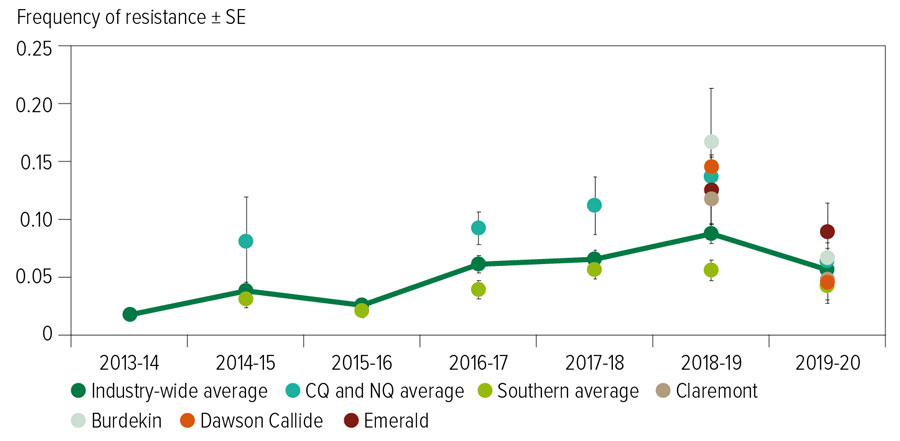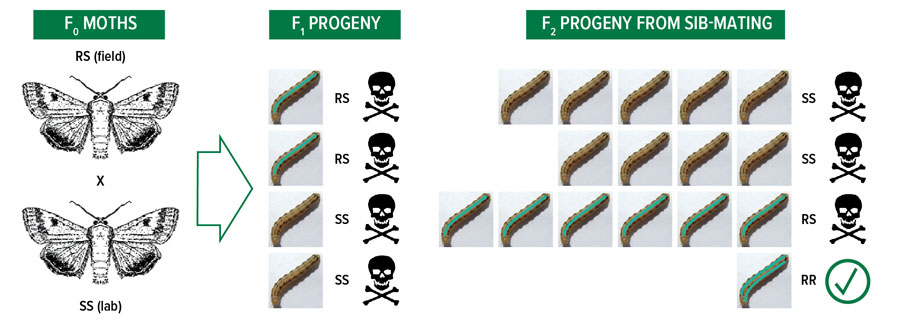Key points
- Cotton bollworm resistance is being informed by surveillance and testing using a bioassay to determine the survival of insect larvae
- Growers are advised to continue to follow the Helicoverpa Resistance Management Strategy
Cotton bollworm (Helicoverpa armigera) larvae damage crops by feeding on developing seed; reducing yield and grain quality. This pest also has a track record for developing resistance in response to insecticide selection pressure, which makes it a challenge to control.
However, each year, with GRDC investment, the NSW Department of Primary Industries conducts cotton bollworm insecticide resistance surveillance to monitor changes in resistance frequency to major selective insecticides used to control H. armigera in grains. The program provides regionally specific information to help growers optimise the cost of effectively and sustainably managing this pest.
Surveillance program
The program utilises F2 screening to increase capacity for detecting resistance to indoxacarb, emamectin benzoate and chlorantraniliprole, which now have broad registration in pulses.
This type of screening is sensitive for all types of known and novel resistance and involves testing the grandchildren of moths from field populations to determine the genetic basis – dominant or recessive – of the resistance. Testing is done by exposing cotton bollworm larvae to a diagnostic concentration of insecticide known to be lethal to susceptible insects and assessing the survivors.
The advantage of using F2 screening is its capacity for measuring underlying resistance by detecting non-conspicuous carriers of resistance genes, even when those genes are recessive and/or at low frequency in the population.
Due to this predictive capability, F2 screening is an important tool in pre-emptive resistance management as it provides growers with an early warning system for identifying potential resistance hotspots. This ability to detect early stage resistance also improves industry preparedness by allowing management tactics to reduce economic losses before spray failures occur and by minimising further spread of resistance genes in the wider cotton bollworm population.
Figure 1: Annual average regional frequency of indoxacarb resistance in northern/central Queensland compared with the industry and southern averages ± binomial standard error (SE).

Source: NSW DPI
Figure 2: F2 screen for detection of resistance alleles. Moths are collected from pheromone traps and, in this example, one parent has one copy of the resistance gene (RS). Their F1 progeny are sib-mated (brother x sister) to produce the F2 generation. If resistance is completely recessive, then only 1 in 16 of the F2 progeny will be homozygous (RR) for the resistance gene and will survive a diagnostic dose of insecticide. The remaining susceptible (SS) and heterozygous (RS) progeny will be killed.

Source: NSW DPI
Resistance results
Emamectin benzoate: No resistance detected to date.
Chlorantraniliprole: Resistance has been generally low (less than 0.5 per cent), apart from occasional levels of two per cent detected in southern and Central Queensland. In 2019-20 there was no resistance detected, indicating that genes for resistance to this insecticide are still rare in the H. armigera population.
Indoxacarb: Resistance has been of concern in recent years, with increases in both 2016-17 and 2018-19, particularly in northern and Central Queensland, where resistance was 2.4 times higher than in southern regions (see Figure 1). By the end of 2018-19, 14 per cent of the H. armigera population in northern and Central Queensland carried at least one gene for indoxacarb resistance. There was a significant reduction in resistance last season, with levels dropping from 10 per cent in 2018-19 to six per cent in 2019-20, with the most marked reductions in northern and Central Queensland.
This decline in resistance could be due to drought in 2018-19; the downturn in production meaning less spraying and reduced selection pressure for resistance.
It is recommended that growers continue to be guided by the Helicoverpa Resistance Management Strategy. This aims to slow the rate of resistance development to insecticides on which the grain industry relies. The strategy is based on best practice treatment windows, which are periods within the cropping calendar when insecticides can be used. They are designed to help growers rotate insecticides. This minimises exposure to products with the same chemical mode of action group and reduces selection pressure across consecutive generations of cotton bollworm.
More information: Resistance management strategy for Helicoverpa armigera in Australian grains; Dr Lisa Bird, 02 7663 1128, lisa.bird@dpi.nsw.gov.au

























































